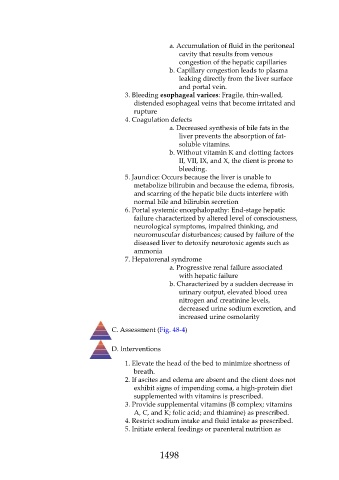Page 1498 - Saunders Comprehensive Review For NCLEX-RN
P. 1498
a. Accumulation of fluid in the peritoneal
cavity that results from venous
congestion of the hepatic capillaries
b. Capillary congestion leads to plasma
leaking directly from the liver surface
and portal vein.
3. Bleeding esophageal varices: Fragile, thin-walled,
distended esophageal veins that become irritated and
rupture
4. Coagulation defects
a. Decreased synthesis of bile fats in the
liver prevents the absorption of fat-
soluble vitamins.
b. Without vitamin K and clotting factors
II, VII, IX, and X, the client is prone to
bleeding.
5. Jaundice: Occurs because the liver is unable to
metabolize bilirubin and because the edema, fibrosis,
and scarring of the hepatic bile ducts interfere with
normal bile and bilirubin secretion
6. Portal systemic encephalopathy: End-stage hepatic
failure characterized by altered level of consciousness,
neurological symptoms, impaired thinking, and
neuromuscular disturbances; caused by failure of the
diseased liver to detoxify neurotoxic agents such as
ammonia
7. Hepatorenal syndrome
a. Progressive renal failure associated
with hepatic failure
b. Characterized by a sudden decrease in
urinary output, elevated blood urea
nitrogen and creatinine levels,
decreased urine sodium excretion, and
increased urine osmolarity
C. Assessment (Fig. 48-4)
D. Interventions
1. Elevate the head of the bed to minimize shortness of
breath.
2. If ascites and edema are absent and the client does not
exhibit signs of impending coma, a high-protein diet
supplemented with vitamins is prescribed.
3. Provide supplemental vitamins (B complex; vitamins
A, C, and K; folic acid; and thiamine) as prescribed.
4. Restrict sodium intake and fluid intake as prescribed.
5. Initiate enteral feedings or parenteral nutrition as
1498

